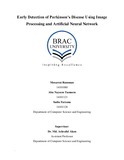Early detection of parkinson’s disease using image processing and artificial neural network
Abstract
Early detection of Parkinson‟s Disease (PD) is very crucial for effective management and treatment of the disease. Dopaminergic images such as Single Photon Emission Tomography (SPECT) using 123I-Ioflupane can substantially detect Parkinson‟s Disease at an early stage. However, till today, these images are mostly interpreted by humans which can manifest interobserver variability and inconsistency. To improve the imaging diagnosis of PD, we propose a model in this paper, for early detection of Parkinson‟s disease using Image Processing and Artificial Neural Network (ANN). The model used 200 SPECT images, 100 of healthy normal and 100 of PD, obtained from Parkinson‟s Progression Marker‟s Initiative (PPMI) database and processed them to find the area of Caudate and Putamen which is the Region of Interest (ROI) for this study. The area values were then fed to the ANN which is hypothesized to mimic the pattern recognition of a human observer. The simple but fast ANN built, could classify subjects with and without PD with an accuracy of 94%, sensitivity of 100% and specificity of 88%. Hence it can be inferred that the proposed system has the potential to be an effective way to aid the clinicians in the accurate diagnosis of Parkinson‟s disease.

